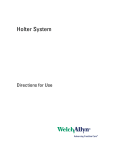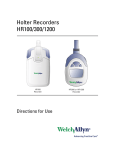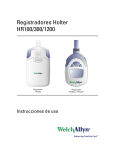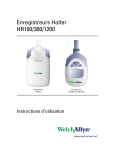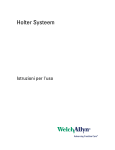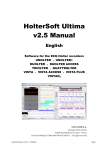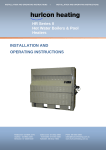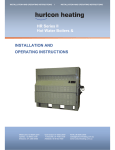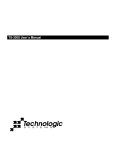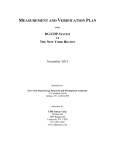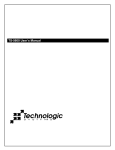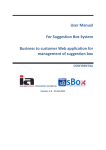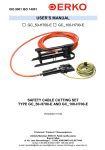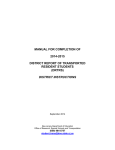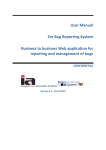Download Expert Holter Software User Manual
Transcript
PCH200 Expert Holter Software System Directions for Use ii Expert Holter Software System Copyright 2006 Welch Allyn. All rights are reserved. No one is permitted to reproduce or duplicate, in any form, this manual or any part thereof without permission from Welch Allyn. Welch Allyn or its vendors assume no responsibility for any injury to anyone, or for any illegal or improper use of the product, that may result from failure to use this product in accordance with the instructions, cautions, warnings, or statement of intended use published in this manual. Welch Allyn, PCH100 and PCH200 are registered trademarks of Welch Allyn. SD is a trademark of Toshiba. Bluetooth is a trademark of Bluetooth SIG, Inc., USA. Software in this product is Copyright 2006 Welch Allyn or its vendors. All rights are reserved. The software is protected by United States of America copyright laws and international treaty provisions applicable worldwide. Under such laws, the licensee is entitled to use the copy of the software incorporated with this instrument as intended in the operation of the product in which it is embedded. The software may not be copied, decompiled, reverse-engineered, disassembled, or otherwise reduced to human-perceivable form. This is not a sale of the software or any copy of the software; all right, title, and ownership of the software remain with Welch Allyn or its vendors. For information about any Welch Allyn product, call Welch Allyn Technical Support: USA +1 800 535 6663 +1 315 685 4560 Australia +61 2 9638 3000 +800 074 793 Canada +1 800 561 8797 China +86 21 6327 9631 European Call Center +353 46 90 67790 France +33 1 55 69 58 49 Germany +49 7477 9271 70 Latin America +1 305 669 9003 Singapore +65 6419 8100 Japan +81 3 3219 0071 Netherlands +31 157 505 000 South Africa +27 11 777 7555 United Kingdom +44 207 365 6780 Global Instrumentation part number 006-700-0035 Version B Manufactured for: Welch Allyn 4341 State Street Road Skaneateles Falls, NY 13153 USA Manufactured by: Global Instrumentation, LLC 8104 Cazenovia Road Manlius, NY 13104 Contract Medical International GmbH Zur Wetterwarte 50, House 302 01109 Dresden Germany Tel: +49 (0) 351 213 88 88 Fax: +49 (0) 351 213 88 99 Contact: European Regulatory Manager Email: [email protected] www.welchallyn.com Printed in USA Sweden +46 85 853 6551 Directions for Use Table of Contents iii Table of Contents Intended Use . . . . . . . . . . . . . . . . . . . . . . . . . . . . . . . . . . . . . . . . . . . . . . . . . . . . 1 Indications for Use . . . . . . . . . . . . . . . . . . . . . . . . . . . . . . . . . . . . . . . . . . . . . . . . 2 Contraindications . . . . . . . . . . . . . . . . . . . . . . . . . . . . . . . . . . . . . . . . . . . . . . . . . 2 Warnings and Cautions . . . . . . . . . . . . . . . . . . . . . . . . . . . . . . . . . . . . . . . . . . . . . 3 Warnings . . . . . . . . . . . . . . . . . . . . . . . . . . . . . . . . . . . . . . . . . . . . . . . . . . . . 3 Cautions . . . . . . . . . . . . . . . . . . . . . . . . . . . . . . . . . . . . . . . . . . . . . . . . . . . . . 3 Symbols . . . . . . . . . . . . . . . . . . . . . . . . . . . . . . . . . . . . . . . . . . . . . . . . . . . . . . . . 4 Introduction. . . . . . . . . . . . . . . . . . . . . . . . . . . . . . . . . . . . . . . . . . . . . . . . . . . . . . 5 Inspection upon Delivery . . . . . . . . . . . . . . . . . . . . . . . . . . . . . . . . . . . . . . . . 5 Before you begin. . . . . . . . . . . . . . . . . . . . . . . . . . . . . . . . . . . . . . . . . . . . . . . . . . 5 System Requirements . . . . . . . . . . . . . . . . . . . . . . . . . . . . . . . . . . . . . . . . . . 5 Optional Requirements . . . . . . . . . . . . . . . . . . . . . . . . . . . . . . . . . . . . . . . . . 6 Holter System Application Directions for Use . . . . . . . . . . . . . . . . . . . . . . . . . . . 7 Activating the Welch Allyn Holter Software . . . . . . . . . . . . . . . . . . . . . . . . . . 7 Starting the Welch Allyn Holter System Application. . . . . . . . . . . . . . . . . . . . 7 Starting a Test . . . . . . . . . . . . . . . . . . . . . . . . . . . . . . . . . . . . . . . . . . . . . . . . 8 Settings. . . . . . . . . . . . . . . . . . . . . . . . . . . . . . . . . . . . . . . . . . . . . . . . . . . . . . . . 20 Physician’s Guide . . . . . . . . . . . . . . . . . . . . . . . . . . . . . . . . . . . . . . . . . . . . . . . . 26 Welch Allyn Service Policy . . . . . . . . . . . . . . . . . . . . . . . . . . . . . . . . . . . . . . . . . 32 Maintenance . . . . . . . . . . . . . . . . . . . . . . . . . . . . . . . . . . . . . . . . . . . . . . . . . . . . 33 Discarding the Equipment . . . . . . . . . . . . . . . . . . . . . . . . . . . . . . . . . . . . . . 33 Technical Specifications . . . . . . . . . . . . . . . . . . . . . . . . . . . . . . . . . . . . . . . . . . . 33 Troubleshooting . . . . . . . . . . . . . . . . . . . . . . . . . . . . . . . . . . . . . . . . . . . . . . . . . 35 Software License . . . . . . . . . . . . . . . . . . . . . . . . . . . . . . . . . . . . . . . . . . . . . . . . 37 iv Table of Contents Expert Holter Software System Directions for Use 1 Directions for Use Intended Use Caution US Federal law restricts this device to sale by or on the order of a physician. The Welch Allyn Holter System is intended to be used as a Holter ambulatory electrocardiograph system for the purpose of screening for ECG rhythm disturbances over a minimum 24-hour period. The Welch Allyn Holter System is intended for use under the supervision of a physician or those knowledgeable in all aspects of ECG morphology, rhythm, and arrhythmia. This procedure is known as a Holter procedure and captures infrequent or activity provoked ECG rhythm abnormalities outside of the physician’s office. The Welch Allyn Holter System is comprised of the Welch Allyn Holter Recorder and the Welch Allyn Holter System Application. As the patient wears the recorder component of the system, it records ambulatory electrocardiograph data. The Welch Allyn Holter System Application analyzes the recorder data. The Welch Allyn Holter System is not intended for infants weighing less than 10 Kg (22 lbs). The Welch Allyn Holter System acquires ambulatory ECG waveforms from patients. The recorder and associated accessories provide signal acquisition for up to three channels (HR100 and HR300) or up to eight channels (HR1200) of patient ECG waveforms through surface electrodes adhered to the body. The subject devices provide the following diagnostic functions: • Acquire, view, store, and print ambulatory ECG waveforms from patients. The recorder and associated accessories provide signal acquisition for up to 12 leads of patient ECG waveforms through surface electrodes adhered to the patient. • Using optional Holter algorithms to generate measurements, data presentations and graphical presentations on an advisory basis for patients. These are presented for review and interpretation by the clinician based upon knowledge of the patient, the results of the physical examination, the ambulatory ECG data full disclosure displays, and other clinical findings. • Using optional interpretive algorithms to generate measurements, data presentations, graphical presentations, and interpretive statements on an advisory basis for patients of sixteen (16) years of age and above. These are presented for review and interpretation by the clinician based upon knowledge of the patient, the results of the physical examination, the ambulatory ECG data full disclosure displays, and other clinical findings. 2 Directions for Use Expert Holter Software System Indications for Use WARNING Safety—Computer assisted ECG data acquisition and interpretation is a valuable tool when used properly. However, no automated interpretation is completely reliable and a qualified physician shall review the interpretations before treatment, or non-treatment, of any patient. The Welch Allyn Holter System is intended for acquiring ambulatory ECG signals from patients. Patients are people with coronary problems or people with suspected coronary problems. This ambulatory electrocardiograph, and associated analysis system, can be used on patients without any limitation on patient age or gender. The Holter Recorder procedure is one of the many tools that clinicians use to capture infrequent or activity provoked ECG rhythm abnormalities outside of the physician’s office. Indications for conducting Holter recording are: • Arrhythmias • Chest pain • Unexplained syncope • Shortness of breath • Palpitations • Evaluation of a pacemaker • Regulation of anti-arrhythmic drugs • Evaluation of a patient after myocardial infarction • Family history of heart disease Contraindications Computer assisted ECG data acquisition and interpretation is a valuable tool when used properly. However, no automated interpretation is completely reliable and interpretations should be reviewed by a qualified physician before treatment, or non-treatment, of any patient. The Welch Allyn Holter System is not intended for infants weighing less than 10 Kg (22 lbs). Directions for Use 3 Warnings and Cautions Familiarize yourself with these warnings. Specific warnings and cautions are also found throughout this manual. Warnings A warning statement in this manual identifies a condition or practice which, if not corrected or discontinued immediately, could lead to patient injury, illness, or death. WARNING Safety—Remove electrodes, patient lead wires, and recorder from patient before defibrillation. WARNING Safety— Inspect recorder and accessories before each use. WARNING Safety—Peripheral equipment and accessories that touch the patient must comply with all appropriate safety, EMC, and regulatory requirements. WARNING Safety— System is not designed for use with high-frequency (HF) surgical equipment and does not protect against hazards to the patient. WARNING Using non-approved cables and accessories may affect the EMC performance. WARNING Stacking of devices or storage near other equipment is not recommended. Cautions A caution statement in this manual identifies a condition or practice which, if not corrected or discontinued immediately, could lead to equipment failure, equipment damage, or data loss. Caution US Federal law restricts this system to sale by or on the order of a physician. Caution Welch Allyn-certified components are required. 4 Directions for Use Expert Holter Software System Symbols Warning. Read Carefully. Caution / Notices. Read Carefully. Attention: See instructions for use. Meets or exceeds Council Directive 93/42/EEC, MDD, Class IIb SD Secure Digital Memory Card Interface. Bluetooth Wireless Communication Technology Recycling Symbol - Do not dispose of this product as unsorted municipal waste. Prepare this product for reuse or separate collection as specified by Directive 2002/96/EC of the European Parliament and the Council of the European Union on Waste Electronic and Electrical Equipment (WEEE). If this product is contaminated, this directive does not apply. See www.welchallyn.com/weee. Serial Number. Reference Number. Non-ionizing radiation. Directions for Use 5 Introduction This manual is written for clinical professionals with a working knowledge of medical procedures and terminology as required for monitoring cardiac patients. You must read and understand this manual and all other information accompanying the ambulatory electrocardiograph and related options or accessories before: • using the Welch Allyn Holter Recorder and the accompanying Welch Allyn Holter software for clinical applications • before setting up, configuring, troubleshooting, or servicing the recorder Inspection upon Delivery Your new Holter System Application was carefully inspected before shipment. Please inspect all components upon delivery for any damage which may have occurred in transit. If you notice any damage, please contact your shipping agent. If items are missing, contact technical support. Before you begin Your system must meet the recommended requirements to function properly. Please review the System Requirements before attempting to install or use the system. System Requirements • 300MHz Pentium class processor or faster • Windows 2000/XP, with all major service pack updates • 256Mb RAM minimum • 40GB hard drive minimum • Mouse and keyboard • Compact Disc (CD) Reader • Secure Digital Card Reader • Printer with resolution greater than 300 dpi • Monitor with screen resolution set to 1024 x 768 Hard Drive Space Required Hard drive space required for program installation: 30Mb for Holter System Application 8Mb for electronic manuals (optional) 6 Directions for Use Expert Holter Software System Typical Hard Drive Usage Caution Windows® requires a minimum 250Mb of free hard drive space available at all times for virtual memory, print spooling and caching. Failing to comply will degrade system performance or crash the system. • 1Gb for sixteen 24-hour patient reports @ 200 samples per second with full disclosure Storage requirements examples • 24-hour patient report @ 200 samples per second with full disclosure requires 64Mb of hard drive space • 48-hour patient report @ 200 samples per second with full disclosure requires 128Mb of hard drive space Optional Requirements File Storage Database SQL Server 2000 with all major service pack updates, in lieu of MSDE. Requirements for backup • CD Writer to write Holter report files to CD Requirements for Bluetooth Communications Caution Welch Allyn-certified components are required. • Support for Universal Serial Bus (USB) 1.1 or 2.0 • Bluetooth Communications Device (Welch Allyn Part Number 704555) Directions for Use 7 Holter System Application Directions for Use Activating the Welch Allyn Holter Software You must activate your Holter software within 30 days, or the software will lock itself. The activation message displays each time you launch the software until you activate. The best way to activate your software is through the Internet. Activating through the Internet 1. Click the Holter icon. The activation message displays. 2. Select Yes or No. • If you select No, a message displays reminding you that you must activate within 30 days. (Caution: after 30 days, the software will not launch.) • If you select Yes, the system automatically activates itself and the activation screen will not display again. This completes the activation requirement. Activating Manually (No Internet Connection) If the software cannot detect an Internet connection, you must activate the application manually. 1. Launch the Holter System software. The activation message displays. 2. Select Yes or No. • If you select No, a message displays reminding you that you must activate within 30 days. (Caution: after 30 days, the software will not launch.) • If you select Yes, the Manual Activation dialog displays. Click the Print button. Contact Welch Allyn Technical Support (see page ii). You will be asked to provide the information displayed on the printout: • Username • Password • PC Serial Number 1 • PC Serial Number 2 3. Once you receive the Activation Code, type it into the Activation Code box and click Activate. The application launches and the activation screen will not display again. This completes the activation requirement. Starting the Welch Allyn Holter System Application Starting the Welch Allyn Holter System Application 1. Click the Holter System Application icon. The Main Menu displays. 8 Directions for Use Expert Holter Software System Table 1. Main Menu options Button Purpose Test Startup Configures the Holter recorder. Inbox Displays unprocessed tests. File Cabinet Displays processed tests. Settings Set system options, such as print formats. Log Off Log Off. Starting a Test Previewing the ECG (Wireless) 1. Prepare the patient according to the HR100/300/1200 Directions for Use. 2. Remove the battery door. 3. Insert an SD card into the recorder. 4. Insert a new battery (HR100) or batteries (HR300/1200). 5. Start the Holter software application and select Test Startup. 6. If the patient has a previous recording, click Search. A patient list displays. • Use the fields at the top of the patient list to filter your search. • Select a patient. Directions for Use 9 7. Type or select all appropriate information. 8. Click Next. The Recorder Selection window will display. 9. Wait for approximately 20 seconds for the serial number of the recorder to appear in the Recorders in Range window. 10. Click Next. (If no number displays, click Troubleshooting.) 10 Directions for Use Expert Holter Software System v 11. Select: 2 or 3 channel and 24 or 48 hour recording duration. Connect patient and click Next. 12. The following message indicates that the previously recorded test on this SD card has not been downloaded. • If you want to retrieve the data, click No and go to “Retrieving data when Patient Returns with Holter Recording Completed” on page 12. • If you want to overwrite the data, click Yes. Directions for Use 11 13. Verify signal quality (i.e. amplitude and artifact).QRS signal amplitude should be two boxes peak to peak. Select Finish. Test Startup is complete. SD Card Only - No ECG Preview 1. Prepare the patient according to the HR100/300/1200 Directions for Use. 2. Remove the battery door. 3. Remove the SD card from the recorder. 4. Start the Holter software application and select Test Startup. 5. Enter patient information as desired. If this test has a previous recording, use search to find the patient information. Select Next. 6. If the SD card has not been inserted into the reader, the window displays an animation until the card is inserted. 7. Select channels and recorder. 8. Select Finish. 9. Insert SD card into the recorder. Insert a new battery (HR100) or batteries (HR300/ 1200). Retrieving data when Patient Returns with Holter Recording Completed 1. Open recorder door and remove battery. 2. Remove SD card from recorder. 3. Be sure the Holter software application is running and insert an SD card into the SD card reader connected to the computer. 12 Directions for Use Expert Holter Software System 4. The Holter software application will upload and analyze the recorded test information automatically. Monitor the progress in the lower right hand corner of your screen. Test Report Review, Editing and Printing 1. Open the Inbox. 2. Highlight the desired test. Click Open. (If necessary, use the area immediately above the header description to search by Patient ID, Last Name, or First name.) 3. Select Summary Preview, Forms, Arrhythmia Review or Full Disclosure modes. Directions for Use 13 These additional functions are available throughout this review process. Table 2. Additional Functions Function Actions Change Test Start Adjust test start time if necessary. Physician Interpretation Provides a window for entering a report interpretation which is part of the report cover page. Patient Data Make changes/additions to the patient demographics as desired. Print Print the report. Settings Change Clinical settings and report format from default values for this test only. Re-analyze Turn off channels that exhibit persistent quality problems and re-analyze Note: Any previous edits are lost. Summary Preview The Summary tab provides a comprehensive overview of key episodes detected during the recording. The Preview Report Strips tab includes all the automatically-selected and user-inserted ECG strips which will be printed as part of the report. This includes: • Baseline ECG strips taken in the first 5 minutes of the recording • Samples of pauses • Samples of ventricular ectopy • Samples of supraventricular ectopy • Min and Max HR • Tachy and Brady Min and Max RR • Max ST elevation and depression 14 Directions for Use Expert Holter Software System Forms Forms categorize QRS morphologies into four groups, Normal (N), Ventricular (V), Paced Beats (P) and Artifact (X), (the latter facilitates user review of false negatives). A form must have a minimum of 5 similar beats. Other unique morphologies, forms with less than 5 beats, can be viewed by selecting View Unmatched Beats. Each form includes the category label, form number (assigned by the total number of beats in a cluster across all categories) that match this morphology. Selecting a form provides an accompanying 7-second ECG strip that includes the first QRS from the form. By clicking Next, each QRS in the form can be seen in the context of an ECG strip. Right click the form header to re-categorize the form to the new desired category. All changes will be updated when moving to another category. Directions for Use 15 To view all beats in a particular form, double-click the form. 16 Directions for Use Expert Holter Software System Arrhythmia Review The display for Pause episodes, Ventricular ectopy, and Supraventricular ectopy includes a histogram of the episodes, a sample 7-second strip (of the worst case occurrence) and a form associated with the highlighted QRS. View any of the events by selecting the respective bar on the histogram and using Next to view ECG strips for all occurrences. The individual beats and/or the form may be edited at any time. Right-click any ECG strip to delete or add to the final report (all beats within the strip are labeled as artifact or added). Directions for Use 17 Options to view the strip in Full Disclosure include: • • • Right-click the strip and select from the pull-down. Double-click the strip. Select the Full Disclosure tab on the toolbar. The Rate tab provides Heart Rate information, specifically tachy, brady, min/max HR, and min/max R to R intervals. The top graph includes a 24 hour HR plot with user selected periods presented in 1-hour intervals immediately below. Select any of the radio buttons to display a representative ECG strip. Or manually select areas (for example, max HR) and manually insert into the report. Full Disclosure This selection allows you to review the entire recording. Abnormal events are color-coded to make it easy to verify report accuracy. Options for the review include: • • • • Auto Paging, i.e. automatically scrolling through the test and adjustable speed The number of lines displayed - 3, 5, 7, and 10 The number of seconds per line - 10, 15, 20, 25, 30, 35, and 40 Channels to be displayed 18 Directions for Use Expert Holter Software System Use the 7-second window to move to any area to enlarge to diagnostic size for viewing and to insert and label for the final report. Delete areas of artifact using the Delete key. The ECG window moves to the next 7 seconds. Final Preview of Report Before Printing Under Summary Preview, the Preview Report Strips provides a review of all the ECG strips selected to be included in the report. Add additional comments or delete strips as required. Confirm the final report using the Confirm tab. Using the Confirm tab changes the status of the record and moves it to the File Cabinet. Directions for Use 19 Settings Report Format screen options Print format Select report pages for the standard report. To print the report immediately after the test data has been transferred from the recorder, check Auto Print Report on Download. ECG Data format Select Strips - Mini (8 strips per printed page) or Diagnostic (2 per printed page). Select Beat label annotations, i.e., N, S, P, X for display and printouts. Select Channels included on a full disclosure printout Select 10, 30, or 60 seconds per line on a full disclosure printout. Patient demographics required Set mandatory entries required by the Test Start Wizard. Strip setting Set desired gain per channel. Facility Set name and logo to be printed on the top left and right of the cover page. Clinical Settings See the Physician’s Guide for more information. Table 3. Clinical Settings specifications Clinical Settings Range Default Pause 1.0 – 5.0 seconds 2.0 seconds Tachycardia 80 – 250 BPM 100 BPM Bradycardia 20 – 119 BPM 60 BPM ST Depression 0.1 – 5.0 mm 1.0 mm ST Elevation 0.1 – 5.0 mm 3.0 mm ST Duration 1 - 180 seconds 60 seconds ST Reset 1 – 180 seconds 60 seconds SVE Prematurity 10-100 percent 25 percent SVE Atrial Tachy 30-150 BPM 80 BPM 20 Directions for Use Expert Holter Software System User Administration options Setup user logins and authority levels here. New Add new user (user first and last name). Limit 40 characters. Maximum of 20 users are allowed. The system prompts when max number is reached. User ID Limit 20 characters. Edit Edit user selected in list. Disable/Enable User Turn user access off or on for user selected in list. Reset Password Reset user selected password for user selected in list. The new password generated will be the same as your user name and requires change upon login. Enable Administration Check box “unchecked” allows access without user login. Directions for Use 21 System Settings Tab Select: • • • Medications and indications Recorders to be used Filters Summarize settings Caution Using report summarization deletes the full report and raw data. To reduce file size, summarization converts a report (not including full disclosure) to a pdf (4 to 6 MB typical). A list of summarized reports displays in the Inbox (PCH100) or the File Cabinet (PCH200) with a summarized status. Available triggers used to automatically summarize a report include: • Customer Initiated – Summarize button available from the Inbox for the PCH100, and from the filing cabinet in the PCH200. • Automatically by a programmable age threshold • Automatically when confirmed 22 Directions for Use • Expert Holter Software System Check boxes allow user to configure which report pages to send and select strip format Export for EMRs This feature exports a pdf of the final report to an Electronic Medical Records (EMR) system. • Export for EMRs Settings Dialog • Define output directory • Remove Image Output directory • Add Page selection checkboxes • “Test Date” is set on the creation of a new Test • Interp Date is set on “New Interpretation”, and “Update to a test” • The exported file name is a concatenation of substrings, where each substring is separated by a delimiter. The substrings used to build the exported file’s name is configured by selecting which items from the list below will be used. The delimiter used to separate each substring can also be configured: • Test Type • Patient ID • Last Name • Test Date and Time • Test ID • Interpretation Date and Time • The file delimiter character Directions for Use 23 • • Triggers • Initial report upload • Automatically when confirmed • Automatically if the report has been changed or interpretation modified Check boxes allow user to configure which report pages to send and select strip format. Email configuration functionality This feature provides a mechanism to email a PDF of a final report. • EMAIL Setting Dialog • Outgoing Email Server: (SMTP address for example; “smtp-server.twcny.rr.com”) • Outgoing User Name: (Only required if SMTP servers requires user authentication—leave blank if not required.) • Outgoing User Password: (same as User name) • Check boxes allow user to configure which report pages to send and select strip format • Send Test Email Message sends an email to a specified user. This can be used to make sure email settings are working properly. 24 Directions for Use • Expert Holter Software System Email activation in Inbox or File Cabinet The Email dialog box includes standard TO, CC, Subject, and Attachment fields.The attachment: name for the attached PDF file automatically includes the patient ID. Directions for Use 25 Physician’s Guide Overview The Welch Allyn Holter System performs analysis for a minimum of up to 24 hours of ECG digital data as a continuous segment of data. The analysis processing consists of the following sub-processing components: • • • • • • • • Signal Conditioning. QRS Detection and Feature Extraction. Clustering. Beat Classification. Heart Rate Calculation. ST Measurement. Pattern Determination. Strip Determination. The analysis program consists of two major stages. The first stage, main analysis, is responsible for QRS detection, classification, feature extraction, and clustering. The second stage is responsible for pattern, tabulation, and strip determination. This stage is commonly referred to as a re-compile process. During a full analysis, both the main analysis and re-compile stages are executed. The full analysis will typically take two minutes to analyze a 3-channel, 24-hour recording. The Re-compile typically takes only seconds. The Re-Compile occurs multiple times, usually after the clinician has performed edits. For instance, if the clinician changes the hookup time to a different hour or minute, the recompile process would re-tabulate the results based on the new time. Other edits that could trigger a re-compile include: • • • • • • ST Episode threshold changes. SVE prematurity threshold changes. Pause threshold changes. Brady and Tachy threshold changes. Form Edits. Beat Edits. Signal Conditioning The signal processing performed during the analysis is used to remove some of the noise and artifacts normally found during an ambulatory recording. The following types of noise and artifacts may occur: • • • • • • Drift - gradual baseline wander usually caused by respiration. Shift - sudden baseline changes in electrode skin impedance or external contact to electrode site. Rail - amplitude saturation of the signal. Continuous noise of a single frequency- usually associated with high electrode impedance and mains 50 or 60 Hz interference. Burst of noise- usually several frequencies mixed together due to electrical signals from active muscles. Spikes- large amplitude shifts of a short duration. The analysis program applies a collection of several filters to correct for these types of issues. These filters are optimized for the specific sub-process requirements. 26 Directions for Use Expert Holter Software System QRS Detection and Feature Extraction The analysis program detects each QRS for each channel. Each detected QRS has several locations identified including Isoelectric, Q, R, S and ST points. From these locations, additional measurements are made for the width, height, morphology, ST Level, and noise assessment. Clustering The analysis program groups beats based on morphology related information. The clusters created are based on which channels are active. For instance, a single channel event in Ch 1 would only be grouped with other single channel events. Beat Classification The beat classification is performed by evaluating QRS detections, features, R-R intervals, clustering information and noise assessment. The outcome of the classification results in the following beat types: • • • • Normal Ventricular Supraventricular Artifact Heart Rate Calculation The analysis program assigns an R-R interval to each detected QRS based on the time interval to the last labeled QRS. A QRS can be assigned with an unknown R-R interval if the region between the last detected QRS and current QRS contains artifact classifications. Artifact regions can be automatically classified by the analysis program or labeled through clinician editing. The heart rate calculation is reported on each beat. The heart rate for a specific beat is based on the average of 9 R-R intervals centered on the specific beat. This would require the 4 previous R-R intervals, the current beat R-R interval and the next 4 R-R intervals. A valid heart rate will require at least 5 out of 9 valid R-R intervals. If the heart rate cannot be calculated, it will be assigned as an unknown heart rate. The heart rate errors associated with one false positive detection (interpolated noise) would be a +12.5% increase in reported heart rate. A false negative detection (missed beat) would result in a -10% error in reported heart rate. The duration of time required to correct the heart rate calculation would be 9 beats. The HR is displayed for each strip and it represents the HR for the beat closest to the center of the strip. If the clinician selects another beat in the strip, its HR values will be displayed. If the HR cannot be calculated, it will be displayed as a --- value. The HR displayed in Full Disclosure refers to the HR value found for the highlighted strip. This HR value is based on the HR of the beat closest to the center of the strip. Refer to Strip HR above. ST Measurement The ST Level is measured on normal beats with a width less than 110 msec. The ST level is measured on each channel based on the delta between the isoelectric point and ST Level point. The Isoelectric point is defined as an average of points between P and Q. The ST Level point is a rate sensitive offset relative to the R-wave. Directions for Use 27 ST Episodes are determined by summing the average ST level over a period of time. Once the average ST Level exceeds the clinician selectable threshold, a ST Episode will be started. The end point of the ST Episode is determined when the average level falls below the clinician selectable threshold. A valid ST episode is reported when the length of the ST episode exceeds the clinician selectable threshold. If a second ST episode starts within the ST Reset threshold, the second ST episode is considered as part of the previous episode. The clinician has separate ST Elevation and ST Depression thresholds. During each ST episode, the location of the maximum average values is maintained. The analysis program does not identify ST slope levels. The clinician can review the ST strip examples to determine if the ST segment slope is up, down or flat. ST episodes are determined for each channel and for Elevation and Depression. These ST episodes are sorted based on maximum level of depression or elevation and automatically presented as strips within the report. The strip time reflects the time of maximum depression or elevation. The duration of the ST episodes, ranges of displacement, or heart rates are not reported. Pattern Determination The analysis program detects the following ventricular pattern types. N represents any normal beat including S beats. Table 4. Ventricular events patterns Ventricular Event Type Pattern Isolated N-V-N Couplets N-V-V-N Runs (three or more Ventriculars) N-V-V-V-N Bigeminy N-V-N-V-N-V-N Supraventricular detection is based on normal beats only. The normal beat must be premature to the previous normal beat or to the running NN average rate. The prematurity threshold is configurable. The analysis program detects the following supraventricular pattern types: Table 5. Supraventricular events patterns Supraventricular Event Type Pattern Isolated N-S-N Couplets N-S-S-N Runs (three or more Supraventriculars) N-S-S-S-N The analysis program detects the following Rate related patterns: 28 Directions for Use Expert Holter Software System Table 6. Rate related patterns Event Definition Tachy Episodes 15 seconds or more of heart rate that exceeds the Tachy Threshold (user configurable) Brady Episodes 15 seconds or more of heart rate that exceeds the Brady Threshold (user configurable) Pauses any valid R-R interval that exceeds the Pause Threshold (user configurable) Min HR time of minimum heart rate reported for entire procedure Max. HR time of maximum heart rate reported for entire procedure Min R-R beat with the shortest R-R coupling interval reported for entire procedure Max R-R beat with the longest R-R coupling interval reported for the entire procedure The analysis program does not automatically: • Detect Atrial Fibrillation and Flutter. View Pause Review, Supraventricular Review, Rate Graphs Review, and Full Disclosure as an aid to identify these types of Arrhythmia patterns. • Detect Ventricular Fibrillation and Flutter. View Arrhythmia Review and Full Disclosure as an aid to identify these types of Arrhythmia patterns. • Detect and classify any Intraventricular conduction defects. View Forms Review, Arrhythmia Review, and Full Disclosure as an aid to identify these types of Ventricular conduction defects. • Measure P-R interval or produce any automatic classifications of any Atrio-Ventricular (AV) blocks. View Pause Review, Supraventricular Review, Rate Graphs Review and Full Disclosure as an aid to identify these types of AV conduction defects. • Identify Paced beat. A green pacer mark is provided by the program to identify the presence of a pacer firing detected within the recorder. The clinician may reclassify beat or forms as Paced. Strip Determination The analysis program selects automatic strip examples based on the following categories: • Ventricular Isolated (2) • Ventricular Couplets (2) • Ventricular Runs - selected based on longest run (4) • Supraventricular Isolated (2) • Supraventricular Couplets (2) • Supraventricular Runs - selected based on longest run (4) • Pauses - selected based on longest pause (4) • Tachy - selected based on highest Tachycardia Rate (2) • Brady - selected based on slowest Bradycardia Rate (2) • Max. Heart Rate - selected on maximum Heart Rate (1) • Min Heart Rate - selected on minimum Heart Rate (1) • ST Elevation per channel - selected on maximum average ST Elevation found (2 per channel) Directions for Use 29 • ST Depression per channel - selected on maximum average ST Depression found (2 per channel) Report Content The Analysis program provides results in several different formats. The application provides a sample report (MIT 219) you may print to help you understand the report content described below. Each report contains a header and footer that describes patient, date and time of procedure, current clinical settings, and other data. Each report page is sequentially numbered. Summary Page The Summary page contains a section with Patient detail information. This page contains examples of the most severe arrhythmia categories. Pauses, Ventricular and Supraventricular examples are presented as a mini strip format. Adjacent to each strip is some numerical information relative to that pattern category. Both Ventricular and Supraventricular Runs present numerical information for the Longest, Slowest and Fastest Run. The Longest refers to the ventricular run with the largest number of ventricular beats. Slowest and Fastest refer to Runs that contain the highest and lowest Ventricular or Supraventricular Heart Rate. The Ventricular Heart Rate is based on the average Heart Rate of all ventricular beats within the run. Supraventricular heart Rate is based on the Heart Rate of all Supraventricular beats within the run. Tabular The tabular page(s) contains hourly information as well as procedure total related information. It contains 25 hours to allow for a partial hour at the beginning and end of the recording. The tabular contains hourly counts for: • Minimum Heart Rate • Average Heart Rate • Maximum Heart Rate • Total QRS count • Ventricular Run Count • Ventricular Couplet Count • Ventricular Isolate Count • Total Ventricular Count • Ventricular /1000 • Supraventricular Run Count • Supraventricular Couplet Count • Supraventricular Isolated Count • Total Supraventricular Count • Total Pause Count Strips The hard copy strips are presented in two different formats including diagnostic and mini format. The diagnostic page contains two strips that are full scale. The Mini strips are organized as 4 rows of two columns. Calibration marks are provided at the left side of the strip. This calibration mark represents a 1-millivolt amplitude signal in the strip. The clinician can select different scaling factors of x0.25, x0.5, x1.0, x2.0 and x4.0. 30 Directions for Use Expert Holter Software System The calibration width represents a 100 msec marker. Diagnostic strips contain additional tick marks that are 3 seconds apart. These markers are located at the top of each diagnostic strip presentation. Each strip contains the time of day, day of the week, strip type and heart rate at a minimum. For some types of strips, additional information is presented such as Pause duration, ST Level and Run length with Run heart rate. Forms The Forms Page represents the form or clusters that were created. Each form indicates a form count, form classification, and the number of beats in the form. A representative example is shown for each form. Forms can be based on any combination of channels processed. Full Disclosure The Full Disclosure can be printed out in several different formats of 10, 30 and 60 seconds per line. Channel indicators are displayed in the lower right footer to indicate which channels are used. Directions for Use 31 Welch Allyn Service Policy All repairs on products under warranty must be performed or approved by Welch Allyn. Unauthorized repairs void the warranty. In addition, whether or not covered under warranty, any product repair shall exclusively be performed by Welch Allyn certified service personnel. If the product fails to function properly—or if you need assistance, service, or spare parts—contact the nearest Welch Allyn Technical Support Center. For phone numbers, see page ii. Before contacting Welch Allyn, try to duplicate the problem, and check all accessories to ensure that they are not causing the problem. When calling, please be prepared to provide: • • • • • Product name and model number and complete description of the problem. Serial number of your product (if applicable). Complete name, address and phone number of your facility. For out-of-warranty repairs or spare parts orders, a purchase order (or credit card) number. For parts orders, the required spare or replacement part numbers. If your product requires warranty, extended warranty, or non-warranty repair service, please call first the nearest Welch Allyn Technical Support Center. A representative will assist you troubleshooting the problem and will make every effort to solve it over the phone, avoiding potential unnecessary returns. In case a return cannot be avoided, the representative will record all necessary information and will provide a Return Material Authorization (RMA) number, as well as the appropriate return address. An RMA number must be obtained prior to any return. If you have to return goods for service, follow these recommended packing instructions: • • • Remove all cables, sensors, and ancillary products (as appropriate) before packing, unless you suspect they are associated with the problem. Wherever possible use the original shipping carton and packing materials. Include a packing list and the Welch Allyn Return Material Authorization (RMA) number. It is recommended that all returned goods be insured. Claims for loss or damage to the product must be initiated by the sender. 32 Directions for Use Expert Holter Software System Maintenance For maintenance and cleaning procedures, refer to the documentation that came with your computer. Discarding the Equipment Discard the recorder and accessories according to local laws. Please follow the state’s recycling laws or your facility’s recycling policy to ensure proper disposal of the recorder and accessories. For more information on recycling, call the Environment Protection Agency or local authorities. Attention: Do not dispose of this product as unsorted municipal waste. Prepare this product for reuse or separate collection as specified by Directive 2002/96/EC of the European Parliament and the Council of the European Union on Waste Electronic and Electrical Equipment (WEEE). If this product is contaminated, this directive does not apply. See www.welchallyn.com/weee. Technical Specifications Table 7. Technical Specifications Specification Value Rate 30 to 250 BPM QRS Detection amplitude ≥ 0.5 mV Analysis Channels any combination of up to three channels Report Durations up to 48 hours Pacemaker Detection ANSI/AAMI EC38-1998 A/D bit Resolution 0.5 µV Sampling Rate 200 sps, 500 sps, 1000 sps Mains Filter 50, 60 Hz, off (default=60Hz) Muscle Filter 35, 60 Hz, off (default=off) Baseline Filter 0.5 Hz, off (default=off) Directions for Use 33 Table 8. Bluetooth Protocol FREQUENCY RANGE 2402-2480 MHZ PEAK OUTPUT POWER -11dBm (EIRP) EMISSION DESIGNATOR 864K F1D RATED POWER 0 dBm MODULATION GMSK Conformance to Regulatory Standards International Electrotechnical Commission • CAN/CSA C22.2 No. 601.1-M90 • IEC 60601-2-47, 2001 • USA: UL60601-1 • IEC 60601-1-2, conforms to EN 55011 American Advancement of Medical Instrumentation • ANSI/AAMI EC38-1998 (Device is not defibrillator protected. This device does not support Defibrillator Protection requirements defined in section 4.2.5.2 of the standard.) Australian Electromagnetic Compatibility • AZ/NZS 3200-1-0 34 Directions for Use Expert Holter Software System Troubleshooting If the Holter System Application malfunctions, you may be able to resolve the issue with little loss of time and expense. We suggest following the troubleshooting guidelines below before returning the unit for servicing. Contact Welch Allyn Customer Support (see page ii). Table 9. Lead Quality Problems Condition Cause Actions General Poor Waveform quality 1, 2, 3, 4, 5 See Table 10 . AC interference (even-peaked, regular voltage superimposed on the waveforms). May resemble or coincide with muscle-tremor interference. 1, 2, 3, 4, 5 See Table 10 . If AC interference persists, turn AC Filter on. See “System Settings Tab” on page 22. Muscle tremor interference (random irregular voltage 1, 2, 3, 4, superimposed on the waveforms). May resemble or coincide with AC interference See Table 10 . If muscle tremor interference persists, turn Muscle Filter on. See “System Settings Tab” on page 22. Wandering baseline (an upward and downward fluctuation of the waveform) See Table 10 . If wandering baseline persists, turn baseline filter on. See “System Settings Tab” on page 22. 1, 2, 3, 4, Table 10. Lead Quality Problems Causes and Actions Cause Action 1 Electrodes positioned on a bony area. Reposition electrodes. 2 Insufficient or dried electrode gel Apply new electrode. 3 Oily Skin or body lotions Clean Skin with alcohol or acetone 4 Excessive hair on chest Shave hair from chest prior to hookup 5 Faulty patient cable Replace patient cable. Table 11. Analysis Errors Condition Cause Action Pause errors Low Amplitude signal causing misdetection creating long coupling interval Pause threshold set too low Artifact prevents QRS detections creating long coupling interval. Reposition electrode to increase signal amplitude. Check that Pause threshold set to desired threshold. See “Clinical Settings” on page 20. Ventricular errors Form Incorrectly classified Excessive noisy trace causes false interpolated beats Excessive noisy trace causes distortion of original QRS signal Confirm that Form Classifications are correct and edit any that are not. Improve patient hookup prep. Perform beat edit to correct beat classification Supraventricular errors Excessive noisy trace causes false interpolated beat Prematurity threshold in clinical settings set too low. Confirm that Form Classifications are correct and edit any that are not. Improve patient hookup prep. Perform beat edit to correct beat classification Incorrect Heart Rate Excessive noisy trace causes false interpolated beat artificially elevating Heart Rate Low amplitude signal cause no detection - thus creating an artificially low Heart Rate Improve patient hookup prep. Perform beat edit to correct beat classification. Directions for Use 35 Condition Cause Action Brady errors Low amplitude signal causes no detection Brady threshold set too high Improve patient hookup prep. Perform beat edit to correct beat classification. Check that Brady threshold set to desired threshold. See “Clinical Settings” on page 20. Tachy errors Excessive noisy trace causes false interpolated beat Tachy threshold set too low Improve patient hookup prep. Perform beat edit to correct beat classification. Check that Tachy threshold set to desired threshold. See “Clinical Settings” on page 20. ST Episodes errors Isoelectric Point positioned on P-wave ST Level point positioned on T-wave Delete Incorrect ST Episode strips from report. Excessive Form Count Excessive noisy traces causes distortion to QRS creating different clusters Improve patient hookup prep. Evaluate whether a specific channel has a high degree of artifact and if so re-analyze turning off that channel. Note: re-analysis will lose any previous performed editing. Table 12. Miscellaneous Problems Condition Cause Action Failure to upload report from recorder SD Card Reader not plugged in SD Card Reader location has changed SD Card is corrupt SD Card upload was terminated before completion Insert SD Card reader into USB port. Double-click over SD Card icon with question mark. This launches a dialog to search for SD card drive. Using Windows Explorer, format the SD using FAT and make sure no volume label is included. Restart the application to allow the report to be reuploaded. Test Startup (Wireless) Cannot find recorder USB Dongle not plugged in Recorder out of range > 5 feet Recorder does not have fresh batteries Radio Interferences from other signal sources Wireless Stack incorrectly configured. Insert USB Bluetooth dongle. Recorder needs to be within 5 feet of the USB dongle. Replace battery in the recorder. For Windows 2000 Operating system confirm that the Wireless Stack is set to Widcomm. See Service Personnel Only section under “System Settings Tab” on page 22. For Windows XP with no other Bluetooth drivers installed, confirm that Wireless stack is to set to Microsoft. For Windows XP systems that have Bluetooth drivers installed confirm that wireless stack is set to Widcomm. Test Startup (Wireless) - Fails Communication failed with recorder. to enter preview mode Recorder out of range > 5 feet Click Start button to try to connect again. Move recorder to within 5 feet of the USB dongle. Project activation fails (Internet) Internet access is blocked Request temporary internet access from your IT staff. (Only required during activation.) Project activation fails (Manual) Invalid Manual release codes Carefully re-type release code. Contact Welch Allyn customer support. Failed to print Printer Off-line Printer out of paper Printer not connected Confirm that printer is online. Confirm printer has paper. Confirm printer connected. Using another application, test the printer. Make sure proper printer is selected with application. 36 Directions for Use Expert Holter Software System Software License The software provided with the Welch Allyn Holter System consists of software written by Welch Allyn, Inc. or its vendors (the Welch Allyn Holter System Software), as well as software written by third parties (the Third-Party Software). The Welch Allyn Holter System Software is governed by this license, and the Third-Party Software is governed by licenses that can be found in the license files in the directories for the respective Third-Party Software contained on the CD-ROM Disc that is furnished with the Welch Allyn Holter System. If any updates are periodically provided for the Welch Allyn Holter System Software or any Third-Party Software, such software updates will be governed by the relevant license for that software unless a different license agreement is provided with the update. READ THE TERMS AND CONDITIONS OF THIS LICENSE AGREEMENT AND THE LICENSES FOR THE THIRD-PARTY SOFTWARE CAREFULLY BEFORE OPERATING THE Welch Allyn Holter System. THE Welch Allyn Holter System SOFTWARE AND THIRD-PARTY SOFTWARE ARE COPYRIGHTED AND LICENSED (NOT SOLD). BY OPERATING THE Welch Allyn Holter System YOU ARE ACCEPTING AND AGREEING TO THE TERMS OF THIS LICENSE AGREEMENT AND THE LICENSES FOR THE THIRD-PARTY SOFTWARE. IF YOU ARE NOT WILLING TO BE BOUND BY THE TERMS OF THIS LICENSE AGREEMENT AND THE LICENSES FOR THE THIRD-PARTY SOFTWARE, YOU SHOULD PROMPTLY RETURN THE Welch Allyn Holter System TO WELCH ALLYN. THIS LICENSE AGREEMENT REPRESENTS THE COMPLETE AGREEMENT CONCERNING THE Welch Allyn Holter System SOFTWARE BETWEEN YOU AND WELCH ALLYN, AND IT SUPERSEDES ANY PRIOR PROPOSAL, REPRESENTATION, OR UNDERSTANDING YOU MAY HAVE HAD. END USER LICENSE AGREEMENT FOR Welch Allyn Holter System SOFTWARE 1. License Grant. Welch Allyn, Inc. (hereinafter Welch Allyn) hereby grants to you, and you accept, a nonexplosive license to use the machine-readable, object code form of the Welch Allyn Holter System Software, whether provided on the media packaged with the Welch Allyn Holter System or pre-installed on the Welch Allyn Holter System (collectively referred to as the “Software”), as well as the accompanying User Instructions or Documentation, only as authorized in this License Agreement. The Software may be used only on one computer. Neither concurrent use on two or more devices or computers, nor use in a network, is permitted without separate authorization from Welch Allyn. * You agree that you will not assign, re-license, transfer, rent, or share your rights under this License Agreement, except that you may permanently transfer all of your rights under this License Agreement as part of a sale or other transfer to a third party of the Welch Allyn Holter System with which the Software was packaged and sold, provided that you transfer all of the Software without retaining a copy, and the transferee agrees to the terms of this License Agreement. * You agree that you will not reverse assemble, reverse compile, or otherwise translate the Software. * You may use the Software media for backup purposes. No copies of the Software or any portion thereof may be made by you or any person under your authority or control. 2. Welch Allyn's Rights. You acknowledge and agree that the Software and the User's Instructions or Documentation are proprietary products of Welch Allyn, protected under U.S. copyright law. You further acknowledge and agree that all ownership rights and title in and to the Software, including associated intellectual property rights, are and shall remain with Welch Allyn. This License Agreement does not convey to you any ownership in or to Directions for Use 37 the Software, but only a limited right of use that is revocable in accordance with the terms of this License Agreement. 3. License Fees. The Software is licensed to you in consideration of your purchase of the Welch Allyn Holter System. 4. Term. This License Agreement is effective upon your operation of the Welch Allyn Holter System and shall continue until terminated. You may terminate this License Agreement by returning the Welch Allyn Holter System to the dealer from which you purchased it within the time permitted for returns under your purchase agreement. Welch Allyn may terminate this License Agreement if you violate any condition of, or default in performing any obligation required by, the License Agreement. Upon termination by Welch Allyn, you agree to return the Software to Welch Allyn. 5. Limited Warranty. Welch Allyn warrants, for your benefit alone, for a period of 12 months after the date of commencement of this License Agreement (referred to as the “Warranty Period”) that during the Warranty Period the Welch Allyn Holter System Software will operate substantially in accordance with the functional descriptions or specifications in the User's Instructions or Documentation. Updates to the Welch Allyn Holter System Software are covered by an Update Warranty Period of 90 days after delivery of the Update to you. Welch Allyn does not warrant that the Welch Allyn Holter System Software is free from defects, nor that it will operate error-free or produce results that will meet your requirements. If during the Warranty Period, a defect in the Welch Allyn Holter System Software appears, you may return it to Welch Allyn and at Welch Allyn's sole discretion, it will either: 1) fix or replace the Welch Allyn Holter System Software, or 2) refund to you the price you paid for the Welch Allyn Holter System. If a defect in an Update of the Welch Allyn Holter System Software appears during the Update Warranty Period, you may notify Welch Allyn, and Welch Allyn will use all commercially reasonable efforts to fix or replace the Updated Welch Allyn Holter System Software. You agree that the foregoing constitutes your sole and exclusive remedy against Welch Allyn for the failure of any warranties made under this License Agreement. EXCEPT FOR THE WARRANTIES SET FORTH ABOVE, THE SOFTWARE IS LICENSED “AS IS,” AND WELCH ALLYN DISCLAIMS ANY AND ALL OTHER WARRANTIES, WHETHER EXPRESS OR IMPLIED, INCLUDING, WITHOUT LIMITATION, ANY IMPLIED WARRANTIES OF MERCHANTABILITY OR FITNESS FOR A PARTICULAR PURPOSE. 6. Limitation of Liability. The cumulative liability of Welch Allyn to you or any other party for any loss or damages resulting from any claims, demands, or actions arising out of or relating to this License Agreement shall not exceed the price you paid for the Welch Allyn Holter System. In no event shall Welch Allyn be liable for any indirect, incidental, consequential, special, or exemplary damages or lost profits, even if Welch Allyn has been advised of the possibility of such damages. 7. Governing Law. This License Agreement shall be construed and governed in accordance with the laws of the State of New York, USA. 8. No Waiver. The failure of either party to enforce any rights under this License Agreement or to take action against the other party in the event of any breach hereunder shall not be deemed a waiver by that party as to the subsequent enforcement of such rights. 38 Directions for Use Expert Holter Software System 39 Limited Warranty Holter System Application This product is sold by Welch Allyn under the warranties set forth in the following paragraphs. These warranties are extended only to the end user with respect to the purchase of this product directly from Welch Allyn or Welch Allyn’s authorized distributors as new merchandise. For a period of 1 year from the date of original delivery to the buyer, the recorder, software, and hardware components are warranted to be free from functional defects in materials and workmanship and to conform in all material respects to the description of the product contained in the Directions For Use and accompanying labels and/or inserts. For a period of 3 months this same warranty is made for accessories (including patient cables) provided by Welch Allyn. Warranty of accessories purchased separately from listed suppliers will be the responsibility of the listed suppliers. This warranty is valid only if (a) all equipment is approved for use with the recorder by Welch Allyn and are installed according to instructions provided by Welch Allyn or its authorized distributors; (b) the product is properly operated under conditions of normal use in accordance with applicable safety and regulatory requirements; (c) replacements and repairs are made in accordance with the instructions provided by Welch Allyn; (d) only recorder or other software authorized by Welch Allyn is used on the workstation; (e) the product has not been configured, modified, adjusted or repaired other than by Welch Allyn or by persons expressly authorized by Welch Allyn, or in accordance with written instructions provided by Welch Allyn; (f) the product has not been subject to misuse, negligence or accident. Welch Allyn’s sole and exclusive obligation, and buyer’s sole and exclusive remedy under the above warranties, is limited to repairing or replacing, free of charge, a product which is reported to Welch Allyn customer service as listed on page ii. Welch Allyn shall not be otherwise liable for any damages including, but not limited to, incidental, consequential, or special damages. There are no express or implied warranties which extend beyond the warranties in this document. Welch Allyn makes no warranty of merchantability or fitness for a particular purpose. Welch Allyn’s sole and exclusive obligation, and buyer’s sole and exclusive remedy under the above warranties, is limited to repairing or replacing, free of charge, a product which is reported to Welch Allyn customer service as listed on page ii. Welch Allyn shall not be otherwise liable for any damages including, but not limited to, incidental, consequential, or special damages. There are no express or implied warranties which extend beyond the warranties in this document. Welch Allyn makes no warranty of merchantability or fitness for a particular purpose. 40 Limited Warranty Expert Holter Software System 4341 State Street Road, PO Box 220, Skaneateles Falls, NY 13153-0220 USA 800 535 6663 www.welchallyn.com Global Instrumentation part number 006-700-0035














































